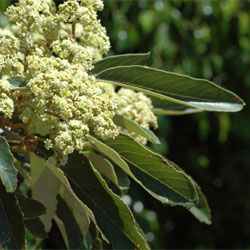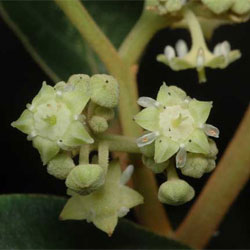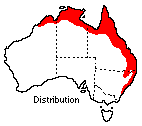Alphitonia excelsa
 |
 |
|
Red Ash, Leatherjacket, Coopers Wood
Alphitonia excelsa (A.Cunn. ex Fenzl) Benth.
Alphitonia excelsa, the Red Ash, sometimes called Leatherjacket or, when found growing on the coast, Coopers Wood, is a member of the Rhamnaceae family, which contains 25 Australian genera and is well represented beyond Australia.
Apart from its value as an ornamental tree, Alphitonia excelsa serves as a fodder plant for both sheep and cattle, and is not as astringent as some edible species. Its wood is useful for tool handles, cabinet work and building purposes, and when first cut is a light colour, gradually darkening at the heart.
When planted in a well-drained position it makes a splendid shade tree which can grow to a height of about 21 m in warm moist conditions; or it can remain as a relatively smaller tree when grown in open situations in Canberra or similar climates.
It can be easily recognised when the young shoots are bruised or broken, as it gives off a peculiar odour similar to sarsaparilla.
 A.
excelsa is widely distributed in the Eucalypt forests of the Northern
Territory and Queensland and in the coastal regions from northern Queensland
to the south coast of NSW, in or near rainforests. It has also been identified
growing in Brigalow scrub in the interior of NSW, in areas such as Narrabri.
The specimens growing in the northern part of the country have a much rougher
bark than those found in the southern regions, the latter having smooth or nearly
smooth bark.
A.
excelsa is widely distributed in the Eucalypt forests of the Northern
Territory and Queensland and in the coastal regions from northern Queensland
to the south coast of NSW, in or near rainforests. It has also been identified
growing in Brigalow scrub in the interior of NSW, in areas such as Narrabri.
The specimens growing in the northern part of the country have a much rougher
bark than those found in the southern regions, the latter having smooth or nearly
smooth bark.
Propagation is from seed which germinates fairly easily, and the species can be regarded as a comparatively fast growing tree.
Alphitonia belongs to the same family as Pomaderris and it is very similar to some species of this genus in both flower and seed formation. The alternate leaves, narrow to elliptic and 7 to 12 cm long, are white or rusty-tomentose (hairy) on the under surface. The young branches and inflorescence may also be clothed in these short rusty hairs.
Flowers, although individually insignificant, cover the tree with clusters of small cream blossoms in late autumn and early winter. The fruits which follow are more attractive, being ovoid, blackish drupes usually 6 to 10 mm in diameter.
Specimens in the Australian National Botanic Gardens have shown little evidence of insect or disease attack, although the tree is semi-deciduous and during winter may give the false impression that it is suffering from one or both of these problems,
The splendid natural shape of A. excelsa is one of its most distinctive features and the foliage extends to near ground level if desired. It has been used as a street tree in some areas where space will allow, such as wide nature strips, but because of its semi-deciduous nature in Canberra may not be suitable for this purpose here.
Text by ANBG staff (1976)
Name meaning: Alphitonia excelsaAlphitonia - from the Greek, alphiton, pearl barley (allusion obscure); excelsa - lofty |
![An Australian Government Initiative [logo]](/images/austgovt_brown_90px.gif)


